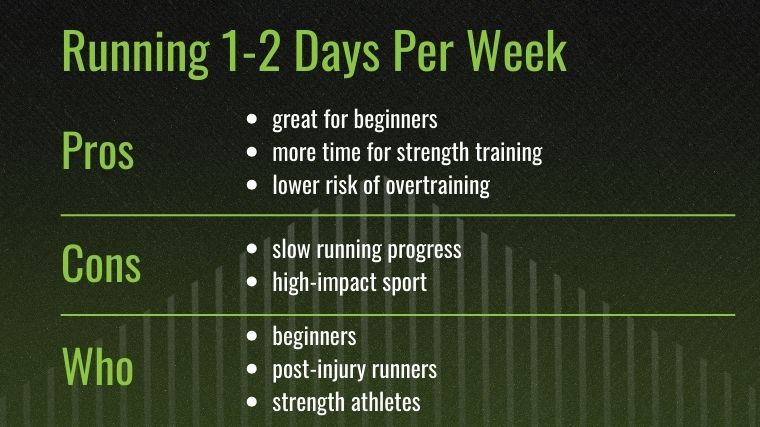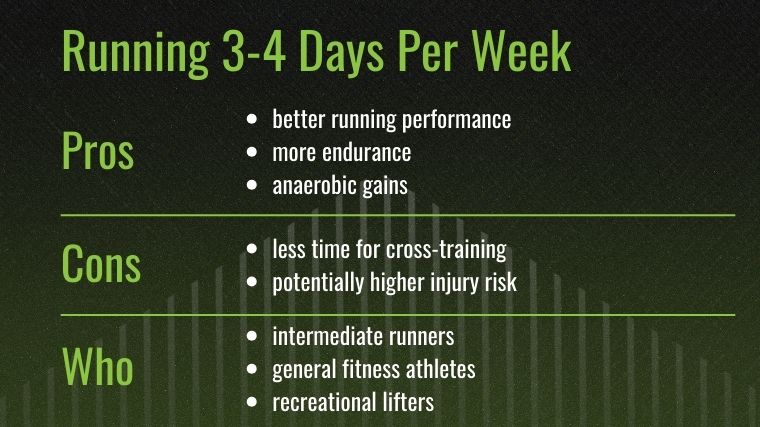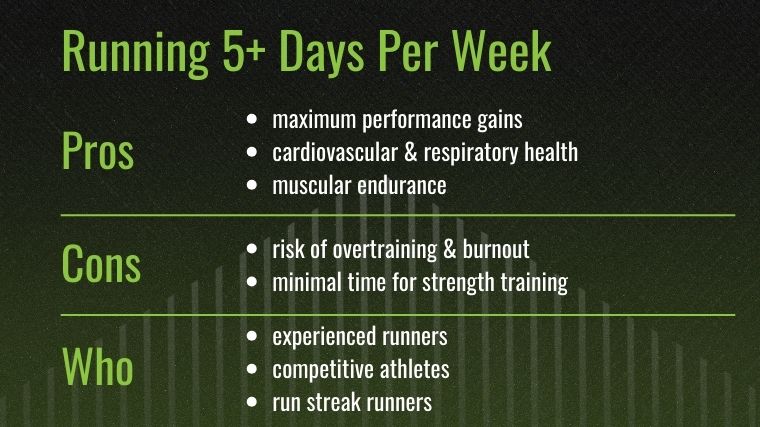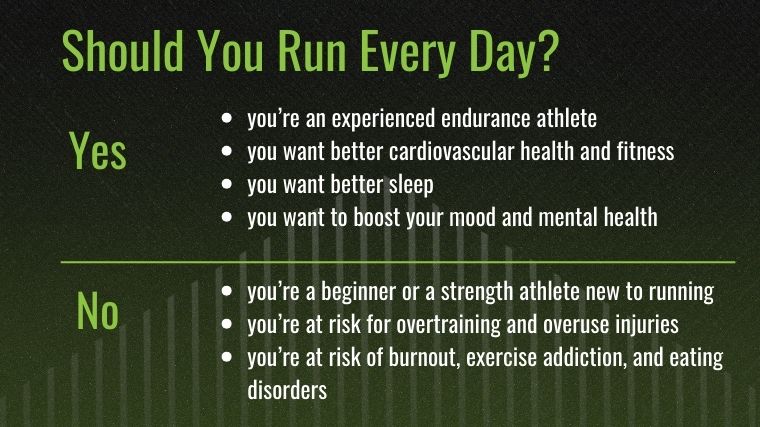There’s nothing like a runner’s high — that mood-boosting feeling of accomplishment after a great run. As a newbie, you may want to chase that feeling by running every day. However, even elite athletes need a rest day. Rest and recovery are critical to making gains in any sport. Athletes balance running and strength training to help their muscle groups support their joints.

As a personal trainer, I’ll lay out how I help my clients incorporate three types of running frequencies into their training plan — with enough room for rest and cross-training. I’ll also dive into what the science says about the risks and benefits of running every day.
Should You Run Every Day?
In the running world, running every single day is called a “run streak.” A run streak can last anywhere from a few days to several years. Runners who keep up a run streak may be athletes, distance runners, or recreational runners who do it for mental health and enjoyment.
People who maintain a run streak for years don’t do longer runs or intense sprinting workouts daily.
Outside of trying to maintain a run streak, you likely don’t need to run every day. You can gain the cardiovascular health benefits of running and prevent overuse injuries by following a balanced training plan.
Running for Cardio
Running is a type of aerobic exercise (or cardio). Aerobic exercise is any physical activity that uses large muscle groups, raises your heart rate and breathing, and can be performed rhythmically and sustained for some time. (1)
The American Heart Association (AHA) recommends adults get 150 to 300 minutes of moderate-intensity aerobic physical activity, 75 to 150 minutes of vigorous-intensity aerobic activity, or a combination of both every week. (They also recommend two days of resistance training.) Reaching this recommendation can boost your cardiovascular health and prevent cardiovascular disease. (2)
[Read More: Expert Tested: The Best Treadmills for Running]
Running generally falls under the vigorous-intensity category. If you want to reach your cardio recommendation through running alone, you could still complete 75 minutes in a week without running every single day — three 25-minute runs would do it. You can also do other forms of exercise to reach these numbers.
Most people live sedentary lives and struggle to reach these goals, so running is a popular option because it is free, fast, and potentially accessible (though not to all people).
How Many Days Should You Run Per Week?
Whether you’re a strength athlete wanting to incorporate running into your training plan, a fitness newbie, or training for a half-marathon, the answer is: it depends.
Between zero days and every day lies three frequency options: one to two days, three to four days, and more than five days. I’ll discuss the pros and cons, who it’s best for, and give a sample weekly breakdown for each.
Running 1-2 Days Per Week

[Read More: The Best Folding Treadmills (Expert Tested)]
Running one to two days per week is a great place to start. You can do two types of running workouts — one longer run at an easy pace and one interval workout, with plenty of time for rest, strength training, and other activities you may enjoy.
- Pros:
- Great for Beginners: Starting with easy runs at a low frequency gives you room to progress. You can add more time and distance to your runs each week and work up to a higher frequency.
- More Time for Strength Training: You have more time in the week to do up to three days of strength training. You want to increase strength and muscle in your lower body to support your runs. You can also work on proper running form.
- Lower Risk of Overtraining: Starting with one to two times per week makes it unlikely that you’ll overdo it. You can still experience running injuries at any frequency, but there is less time spent running for it to happen.
- Cons:
- Slow Running Progress: Running one to two days a week can eventually help you run faster or longer, but progress will be slow. If you have a goal of running a half-marathon or increasing your speed, it’s still great to start here to build up to a higher frequency.
- High-Impact Sport: Even running once a week is a high-impact activity. People with specific joint issues, injuries, or health conditions may avoid high-impact exercise.
- What Kinds of Athletes Should Run 1-2 Days Per Week:
- Beginners should start with one to two days per week.
- Runners returning after an injury would benefit from this frequency after getting cleared by a doctor or physical therapist.
- Strength athletes already dedicate a ton of time and energy every week to their main sport. Adding a short sprint workout after a lifting session or a light jog on an active recovery day could be a good place to add running.
Sample 1-2 Day Per Week Running Program
Here is a sample weekly schedule to try running one to two days per week.
You have three days of strength training — two full-body days with a leg focus and one upper-body day. There is one complete rest day and one for active recovery, where you might want to take a long walk, which helps you prepare to add more running in the future. For less impact on your joints, try swimming or cycling.
- Day 1: Strength Training (Upper Body Day)
- Day 2: Run: Interval Training (15 to 20 minutes)
- Day 3: Rest Day
- Day 4: Strength Training (Full-Body Day + Leg Focus)
- Day 5: Run: Longer Run (20 to 25 minutes; add a few minutes each week)
- Day 6: Strength Training (Leg + Core Day)
- Day 7: Active Recovery Day (Long Walk)
Running 3-4 Days Per Week

[Read More: The Best Cross-Training Shoes (Personally Tested)]
Upping your running frequency to three to four days per week can help you progress quicker, but you may lose some time and energy to dedicate to cross-training. It’s all about finding the perfect balance that feels challenging, sustainable, enjoyable, and safe.
- Pros:
- Better Running Performance: With more time to dedicate to running, you’ll get better at running, which may mean you can run a faster mile.
- More Endurance: Spending more time on longer runs will build your endurance and aerobic capacity.
- Anaerobic Gains: Speed work like tempo runs or HIIT workouts will build your anaerobic capacity and increase your lactate threshold.
- Cons:
- Less Time for Cross-Training: Dedicating your time and energy to running leaves less time for strength training. That’s okay; you’ll just need to zero in on the days you do it to keep your legs strong without overdoing it.
- Potentially Higher Injury Risk: Running more doesn’t necessarily mean you’re more likely to get injured, especially if you scale up slowly. Still, upping the frequency and leaving less time for strength training could increase your injury risk.
- What Kinds of Athletes Should Run 3-4 Days Per Week:
- Intermediate Runners: If you’re following a training plan to run a half-marathon or another long-distance run, three or likely four days per week may be suitable.
- General Fitness Athletes: People hoping to reach the cardio recommendations through running alone can do short runs or jogs three to four times a week. (Just don’t neglect resistance training.)
- Recreational Lifters: If you mainly do resistance training for fun or health, you could get away with two days of lifting to allow for a higher running frequency.
Sample 3-4 Day Per Week Running Program
Ready to run three or four days per week? You’ll do two longer runs and one shorter day for speed work. You have two days of strength training — one full-body and one leg day. You need at least one complete rest day; the other can be active recovery, including a light jog or long walk.
You can measure your longer runs in time or miles, depending on your goal.
- Day 1: Run: Longer Run (30 to 60 minutes)
- Day 2: Strength Training (Full-Body Day)
- Day 3: Rest Day
- Day 4: Run: Speed Work (15 to 20 minutes)
- Day 5: Strength Training (Leg Day)
- Day 6: Active Recovery Day (Light Jog or Long Walk)
- Day 7: Run: Longer Run (45 to 60 minutes)
Running More Than 5 Days Per Week

[Read More: The Best Commercial Treadmills on the Market]
Want to ramp it up? Here are the pluses and minuses of a high running frequency.
- Pros:
- Maximum Performance Gains: Running this frequently with good running form will help you run faster and longer.
- Cardiovascular and Respiratory Health: Regularly running more than five days per week significantly strengthens your cardiovascular system and respiratory health.
- Muscular Endurance: While running doesn’t necessarily build muscle, your muscles will become strong enough to withstand this volume. They’ll also be able to support longer runs before fatiguing.
- Cons:
- Risk of Overtraining: Running more than five days per week without overtraining is possible, but the risk is higher.
- Risk of Burnout: Although many enjoy running for mental health benefits, increasing your frequency also increases your risk of burnout. You could be experiencing burnout if you stop enjoying it, dread your runs, have persistent soreness, experience frequent injuries, and your performance declines.
- Minimal Time for Strength Training: Running is now your primary sport and the top priority for physical activity.
- What Kinds of Athletes Should Run More than 5 Days Per Week:
- Experienced Runners: Advanced runners are already trained to withstand this volume. They know how to recover well and incorporate cross-training effectively.
- Competitive Athletes: Endurance athletes and marathon runners may be running this much.
- Run Streak Runners: Folks on years-long run streaks are running every single day, though (hopefully) alternating the length and intensity of their runs.
Sample 5+ Day Per Week Running Program
Here’s how to fit it all in. You have two days of pure long runs (time and distance depending on your goal) and one day of an intense tempo run meant to build your anaerobic capacity. On your strength training days, you’ll focus on your legs and core and follow up with an easy run on one day and a sprint HIIT workout on the other.
You have an active recovery day, which can include a jog, and one complete rest day (which should still include mobility work and stretching).
- Day 1: Run: Longer Run
- Day 2: Strength Training (Light Leg Day + Core) + Easy Run
- Day 3: Active Recovery Day (Light Jog)
- Day 4: Run: Tempo Run
- Day 5: Rest Day
- Day 6: Run: Longer Run
- Day 7: Strength Training (Light Leg Day + Core) + Sprint HIIT Workout
What Running Every Day Does to Your Body
Running every day can have both positive and negative effects on your body.
It’s important to care for yourself by wearing the right running shoes, potentially working on your running form with a running coach, taking the rest days your body needs, and doing cross-training to strengthen your muscles.
[Read More: The Best Treadmills for Bad Knees]
- High-Impact Sport: When you run, each time your foot hits the ground, your joints take on the force of three to four times your body weight. In some cases, high-impact, weight-bearing activity can strengthen your bones. For heavier people, it may increase your risk of injury. Doing it every day only further compounds the risk. (3)(4)(5)
- Weight Loss: Running every day is one way of burning calories, which boosts your total daily energy expenditure (TDEE) and can lead to weight loss. If you run every day at a high intensity, it’s important to eat enough to fuel your body and recover well.
- Cardiovascular Health and Fitness: Running every day will offer similar (potentially more) outcomes to other forms of daily aerobic exercise. It will strengthen your cardiovascular system, help prevent cardiovascular diseases, improve oxygen uptake and lung health, and boost mental health and well-being. (6)
Benefits of Running Every Day
Many people run every day — here’s why.
- Cardiovascular Health: A few studies investigated the benefits of running or jogging every day; here are some findings.
- One study compared running with the risk of cardiovascular diseases and all-cause mortality in 55,137 people aged 18 to 100. Runners had a 30 to 45 percent lower risk of death than nonrunners and lived an average of three more years. The study found that running five to ten minutes daily at less than six miles per hour is sufficient to lower your risk of cardiovascular disease and all-cause mortality. (7)
- A study also found that running six miles per week, one to two times per week, for 51 minutes total, at less than six miles per hour, is enough to reap the health benefits of running every day. (8)
- The Copenhagen City Heart study analyzed 18,000 joggers and non-joggers of all genders aged 20 to 98. Joggers had lower resting heart rates, lower blood pressure, lower cholesterol, and a lower risk of diabetes. Joggers lived six years longer than non-joggers. The lowest mortality risk was found in people who jogged 2.5 hours per week at a slow pace, three or more times per week. (9)
- Cardiovascular Fitness: Research shows running improves VO2 max and muscular endurance, similar to HIIT training with resistance exercises. (10)
- May Improve Sleep: Regular exercise is well-known to improve sleep. A study on adolescents found that running for 30 minutes every morning for three weeks improved sleep quality and psychological well-being. (11)
- Mental Health:
- Regular exercise is also well-known to improve mental health by alleviating symptoms of anxiety and depression and boosting cognition, self-esteem, and self-image. (12)
- People enjoy running every day for mental health, as well. Feeling accomplished and training for an event can boost self-esteem. A review of studies investigated the link between running and mental health. It found that running at various distances and intensities can positively affect mood, well-being, and mental health. (13)
[Read More: Expert Tested: The Best Cushioned Treadmills]
Risks of Running Every Day
You can enjoy the health and performance benefits of running without running every day. Here are a few risks to consider.
- Overtraining and Injury Risk: A few studies outline how overtraining without adequate rest days causes runners to risk injury.
- One study on endurance athletes found those who took less than two rest days per week had a 5.2 times higher risk of overuse injuries. (14)
- A previously referenced study noted that the health benefits of running level off when you run more than 4.5 hours per week, and the risk of overtraining increases. (7)
- Common Running Injuries: Running injuries may occur due to improper running shoes, poor running form, too much impact and stress on the joints and bones, and lack of muscular engagement from the glutes, hips, quads, hamstrings, and calves. A few common running injuries include runner’s knee (patellofemoral pain syndrome), Achilles tendinopathy, IT band syndrome, runner’s toe, shin splints, plantar fasciitis, and stress fractures. (15)
- Cardiovascular Risk:
- Some studies suggest that daily running, a form of excessive endurance exercise (EEE) can potentially cause adverse cardiovascular effects from changes in the heart structure, chronic oxidative stress, and inflammation. (16)
- Other reports note that evidence has been mixed, and the potential for cardiotoxicity should not scare athletes; the positive cardiovascular effects of running outweigh the potential negatives. (8)
- Mental Health Risk: Daily running can also harm mental health, leading to burnout, exercise addiction, and eating disorders. (13)
Takeaways

[Read More: The Best Treadmills with Screens, As Chosen by Our Experts]
- Should you run every day?
- If you’re going to do it:
- Run for a few minutes every day
- Scale up slowly
- Recover when you can, eat enough, sleep enough, and stretch
- Incorporate strength training around runs
- Reasons to consider not running every day:
- Even elite athletes take rest days
- Running every day increases your risk of overuse injuries
- Doesn’t allow time for quality strength training
- Doesn’t allow time for recovery
- If you’re going to do it:
- Who Should Run 1-2 Days Per Week:
- Beginners
- People coming back from injuries
- Strength athletes with a packed training schedule
- Who Should Run 3-4 Days Per Week:
- Intermediate runners
- Recreational lifters with room in their training plan
- General fitness joggers
- Who Should Run More Than 5 Days Per Week:
- Experienced runners
- Competitive running athletes
- Dedicated run streak runners
- What Running Every Day Does to Your Body:
- High impact and stress on your joints
- Weight loss may occur
- Improves cardiovascular health and fitness
- Benefits of Running Every Day:
- Improves cardiovascular health and fitness
- Better sleep
- Boosts mood and mental health
- Risks of Running Every Day:
- Risk of overtraining and common running injuries
- Potential cardiovascular risk
- Adverse mental health effects like burnout, exercise addiction, and eating disorders
Frequently Asked Questions
Here are the questions I get most often about daily running.
Is it healthy to run 30 minutes every day?
Running 30 minutes every day may be too much for many athletes. You need time to rest and recover. If you run every day, some of the days should be shorter, less intense runs.
How many days a week should you run?
It depends on your fitness level, goals, and ability to recover. Beginners should start with one to two times per week.
Will running every day keep me in shape?
Running every day will boost your cardiovascular fitness and burn calories, but it can also lead to injuries.
Is it OK to go for a run every day? Or is it bad to run every day?
If you want to run every day, alternate your intensities and length so you’re not running long distances or sprinting every day. Running every day is not necessarily bad, but it could increase your risk of injuries. It is generally safest to take at least one or two rest days and incorporate cross-training into your training plan.
Editor’s Note: The content on BarBend is meant to be informative in nature, but it should not be taken as medical advice. When starting a new training regimen and/or diet, it is always a good idea to consult with a trusted medical professional. We are not a medical resource. The opinions and articles on this site are not intended for use as diagnosis, prevention, and/or treatment of health problems. They are not substitutes for consulting a qualified medical professional.
References
- Patel H, Alkhawam H, Madanieh R, Shah N, Kosmas CE, Vittorio TJ. Aerobic vs anaerobic exercise training effects on the cardiovascular system. World J Cardiol. 2017 Feb 26;9(2):134-138.
- Piercy, K. L., & Troiano, R. P. (2018). Physical Activity Guidelines for Americans From the US Department of Health and Human Services. AHA Journal, 11(11).
- Glancy, J., CO (1984). Orthotic Control of Ground Reaction Forces During Running (A Preliminary Report). Orthotics and Prosthetics, 38(3), 12-40.
- Williams PT. Effects of running and walking on osteoarthritis and hip replacement risk. Med Sci Sports Exerc. 2013 Jul;45(7):1292-7.
- Winter, S. C., Gordon, S., Brice, S. M., Lindsay, D., & Barrs, S. (2020). A Multifactorial Approach to Overuse Running Injuries: A 1-Year Prospective Study. Sports Health.
- Your lungs and exercise. Breathe (Sheff). 2016 Mar;12(1):97-100.
- Lee DC, Pate RR, Lavie CJ, Sui X, Church TS, Blair SN. Leisure-time running reduces all-cause and cardiovascular mortality risk. J Am Coll Cardiol. 2014 Aug 5;64(5):472-81. doi: 10.1016/j.jacc.2014.04.058. Erratum in: J Am Coll Cardiol. 2014 Oct 7;64(14):1537.
- Lavie CJ, Lee DC, Sui X, Arena R, O’Keefe JH, Church TS, Milani RV, Blair SN. Effects of Running on Chronic Diseases and Cardiovascular and All-Cause Mortality. Mayo Clin Proc. 2015 Nov;90(11):1541-52.
- Peter Schnohr, Jacob L. Marott, Peter Lange, Gorm B. Jensen, Longevity in Male and Female Joggers: The Copenhagen City Heart Study, American Journal of Epidemiology, Volume 177, Issue 7, 1 April 2013, Pages 683–689,
- Menz V, Marterer N, Amin SB, Faulhaber M, Hansen AB, Lawley JS. Functional Vs. Running Low-Volume High-Intensity Interval Training: Effects on VO2max and Muscular Endurance. J Sports Sci Med. 2019 Aug 1;18(3):497-504.
- Kalak N, Gerber M, Kirov R, Mikoteit T, Yordanova J, Pühse U, Holsboer-Trachsler E, Brand S. Daily morning running for 3 weeks improved sleep and psychological functioning in healthy adolescents compared with controls. J Adolesc Health. 2012 Dec;51(6):615-22.
- Sharma A, Madaan V, Petty FD. Exercise for mental health. Prim Care Companion J Clin Psychiatry. 2006;8(2):106.
- Oswald, F., Campbell, J., Williamson, C., Richards, J., & Kelly, P. (2020). A Scoping Review of the Relationship between Running and Mental Health. International Journal of Environmental Research and Public Health, 17(21), 8059.
- Ristolainen L, Kettunen JA, Waller B, Heinonen A, Kujala UM. Training-related risk factors in the etiology of overuse injuries in endurance sports. J Sports Med Phys Fitness. 2014 Feb;54(1):78-87.
- Semciw A, Neate R, Pizzari T. Running related gluteus medius function in health and injury: A systematic review with meta-analysis. J Electromyogr Kinesiol. 2016 Oct;30:98-110.
- Lee, D., Brellenthin, A. G., Thompson, P. D., Sui, X., Lee, I., & Lavie, C. J. (2017). Running as a Key Lifestyle Medicine for Longevity. Progress in Cardiovascular Diseases, 60(1), 45-55.
The post Should You Be Running Every Day? A Certified Personal Trainer Gives You the Scoop appeared first on BarBend.

